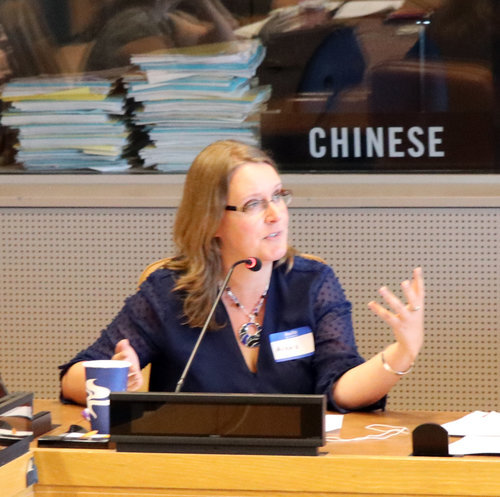Where Women Rebel, Revisited: Cross-National Patterns in Context
By: Alexis Henshaw
I am grateful to the journal for giving me the opportunity to revisit this blog from 2016 and my associated IFJP article “Where Women Rebel.” Reviewing my prior commentary in light of subsequent developments, I see both old and new challenges for our understanding of gender and conflict. As I read this piece in 2020, I am aware of the ongoing international debate over the fates of women affiliated with ISIS and, in many cases, their minor children. The continued detention of individuals in poor conditions at facilities like al-Hol in Syria not only poses questions about human rights and due process, it also has raised new concerns that women in these facilities—who have complained online of lack of food, clean water, and medical care, among other things—may be using these experiences to perpetuate the ideology of the Islamic State. The international community’s ongoing puzzlement over, discomfort with, and even avoidance of violent women is an issue that feminist researchers must continue to highlight.
In the same vein, the landscape of women’s participation in political violence may be changing in ways that call for our attention. While the role of women in the Islamic State and other movements advocating jihad has attracted much scholarly and journalistic interest, the place of women in newer, online, and far-right movements should attract our curiosity as well. As researcher Annie Kelly recently stated in the New York Times, in far-right networks “there are always more women involved than first meets the eye.” The widespread embrace of conspiracy-driven, anti-government movements like QAnon by women is arguably motivated by some of the same factors employed by the Islamic State and many other extremist groups: Appeals to defend the family, to assert the moral authority of mothers, and to question the legitimacy of governments. Unquestionably, there is much work to be done on this issue. I hope feminist scholarship in this area will continue to make inroads in policy-relevant ways, but I also hope policy makers will do their part to support and amplify this work.
This blog was previously published on July 29th, 2016.
My article is an outgrowth of research I did for my dissertation at the University of Arizona (completed in 2013). Sharp-eyed readers will note that my findings cover a sample of rebel movements active between 1990-2008, under a rubric defined in the article. While relatively few new insurgencies have emerged since 2008 (according to UCDP/PRIO’s data), the greatest change has come in which groups we now focus on. In 2016, perhaps no single insurgency will attract greater policy attention or analysis than the Islamic State (ISIS).
While neither ISIS nor its predecessor group, the Islamic State in Iraq (ISI), was included in my sample for Where Women Rebel, the rise of ISIS and the role of women within the organization provides an important opportunity to see what kind of insights my cross-national work can offer when applied to a particular case. In fact, I believe that when viewed in the context of my research, the participation of women in ISIS becomes less surprising in a number of ways.
The inclusion of women in any insurgency is the norm, not the exception. Given my finding that women are present and active in the majority of all armed insurgencies since the end of the Cold War, the existence of women who support the Islamic State should come as a shock to no one. Yet media discourse and policy makers alike continue to puzzle over why women—particularly Western women and girls–would join the organization. The underlying assumption seems to be that it’s counter-intuitive for women to support an organization that undermines their civil and political rights, yet the data I compiled shows that women are present in plenty of insurgencies that have very little to say about the rights of women in a Western, liberal, democratic sense.
The roles women play in ISIS are consistent with other Islamist extremist groups. As with many of the Islamist groups I examined, women in the Islamic State are currently limited to playing a supporting role. This edict was made very clear last year when ISIS’s female religious police, the al-Khans’aa Brigade, published a manifesto for women (see the English translation here). The document outlines a responsibility for women that lies first and foremost in the home, citing Islamic scripture that places men in a position of dominance. Thus, the work of the al-Khans’aa Brigade—i.e., the use of women to police other women—is acceptable, but the involvement of women in direct engagement against foreign forces is not… for now. In a section of its manifesto entitled “Secondary functions of a woman,” a caveat does allow for women to engage in jihad only if “the enemy is attacking her country and the men are not enough to protect it and the imams give a fatwa for it.” This too is something we’ve seen before. Groups like the al-Aqsa Martyrs Brigade were also slow to allow women to carry out armed attacks, i.e. suicide bombings, but they eventually did so—at least to some extent out of necessity. In her examination of jihadist groups, Davis concludes that these organizations begin to loosen restrictions on the use of women as suicide bombers after an average of 13.5 years, suggesting that need at some point trumps ideology. With recent reports suggesting that ISIS has lost a great deal of territory in both Iraq and Syria over the past year, this should give us pause. This could imply that we might see women fighting on behalf of the Islamic State soon.[1]
Agency is complicated, and forced participation isn’t always what it seems. An analysis of ISIS would not be complete without mentioning forced participation. In the article, I acknowledge the difficulty inherent in trying to identify a “forced participant,” and I allude to the complex co-existence of both “forced” and “voluntary” participation in many insurgencies. The case of the Islamic State illustrates this complexity. In ISIS-held territory today, there are women who are slaves living alongside women who voluntarily joined the organization. In between these groups lies a large gray area. Namely, women like those interviewed last year in the New York Times—Syrian women who were not exactly forced into ISIS, but who agreed to collaborate to protect their own. For some women, collaboration may also be their only means of remaining connected with the world outside their homes. Are these women terrorists? War criminals? The question of how we view them is not just relevant in an academic sense; it is a concern that will have to be recognized in any future peace and reconciliation process.
With all these similarities to other armed groups, is there anything about the position of women in ISIS that is unique? I think so. In my studies, I saw few if any other organizations that succeeded in mobilizing a large, transnational contingent of women. For ISIS, that may turn out to be a blessing and a curse.
As noted above, women in ISIS-held territory exist within a rigid social hierarchy. While the women enslaved by the group are clearly at the bottom of that order, the New York Times interview linked above exposes an interesting fault line. The Syrian women who served with the al-Khans’aa Brigade seemed to think women who were foreign recruits enjoyed privilege. They report that these women got better weapons, petty cash, and more freedoms. The suggestion that ISIS is–intentionally or unintentionally–pitting women against one another is worth some attention. A PBS Frontline special last year already showed how women are fighting ISIS from within: Coordinating group rescues, reporting on building floor plans, and passing along information about checkpoints. While Frontline focused on the efforts of Yazidi women, many of whom are held in slavery, reluctant collaborators like those mentioned above might be in a position to do even more. But that depends on our ability to see women as combatants, to understand their motivations, and to value their potential as agents of change.
[1]In spite of some high-profile reports in 2015, the ISIS restrictions on women in combat still stand. Early reports of a female suicide bomber in Paris were discredited, while San Bernardino shooter Tashfeen Malik’s Facebook pledge to the Islamic State does not suggest a direct link.
Read the article here: ‘Where Women Rebel: Patters of Women’s Participation in Armed Rebel Groups 1990–2008’
Each blog post gives the views of the individual author(s) based on their published IFJP article. All posts published on ifjpglobal.org remain the intellectual property and copyright of the author or authors.
UN CTED and UN Women (2018
Dr. Alexis Henshaw is the author of Why Women Rebel: Understanding Women’s Participation in Armed Rebel Groups (Routledge, 2017) and co-author of Insurgent Women: Female Combatants in Civil Wars (Georgetown University Press, 2019). She is currently an assistant professor at Troy University.
Her research interests include gender issues in international politics, civil wars, conflict management, and Latin America. She has also published work on research methods and design, including pieces focused on pedagogy, data analysis & visualization, and inclusivity. Her work has appeared in Journal of Global Security Studies, International Feminist Journal of Politics, Studies in Conflict & Terrorism, Small Wars & Insurgencies, and a variety of other peer-reviewed outlets.


